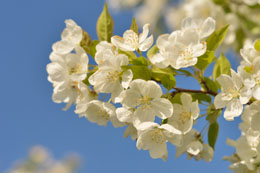If your Bradford pear tree has reached a good height, then it is high time that you should prune the tree. Peep in to find instructions on pruning and trimming a Bradford pear tree.

Bradford pear trees are beautiful trees used for landscaping front yards. These trees are more famous for its decorative value than fruit bearing attributes. These trees bear round-shaped green-colored leaves, which have a smooth edge. The height of these trees varies between thirty to fifty feet. During fall, these trees just look white and are absolutely without any leaves. Fruits can be visible in late spring or early summer. Fruits are smaller in size and brown in color, and not easily noticeable. Spring is the best time for flowering; the flowers are white in color, having multiple petals. Pruning is required for proper growth of this tree.
When to Prune Bradford Pear Trees
★ The tree is hardy in USDA zones 5 through 9. Thus, it requires regular pruning for it to be in shape and prevents limbs from wearing off. The best time to start pruning the trees is just after the blooming season, preferably in May or June.
★ Trimming can be done by seeing the shape of the tree, before the foliage covers all its branches. As these trees are placed on the roadside, they need to be shaped properly to give a good look. Annual pruning helps these trees to grow more vigorously and also to get the blooms in right time.
Instructions for Pruning
★ First, clean the surroundings where you have planted it. Get rid of dead branches that have become black in color and also the diseased ones. Deadwood draws the nutrients from the tree and encourages the growth of pests and eventually, stunts the growth of the tree.
★ Start with choosing the central trunk of the tree, the leader. Crop the branches that go parallel to it by half.
★ Prune out weaker branches that have grown at a 15-inch distance from each other. If you notice two large limbs growing together, crop the one that is weaker.
★ Only the branches that have grown at an angle of 45 degree, need to be retained. Remove the ones that don't follow suit.
★ Remove any fruit that's matured as Bradford pear tree fruits are non-edible for humans, and poisonous for dogs.
★ Remove branches that seem infected with mold or other diseases. Apply a concentrate to avoid further growth.
Pruning Older Trees
● First of all, if pruning an older tree, be prepared to deal with a maze of limbs and twigs.
● Identify the core trunk of the tree; that will help you to decide from where you should start trimming the secondary branches. Start cutting the secondary branches from the base of the tree, because as they grow upward they lose strength. If you do not cut them, they will give improper shape to your tree.
● Cut all the branches which are overlapping with one another and remove the parallel growing limbs.
● Cut down all the weak and dead branches.
● Trim the branches in a way that the shape of the plant is maintained. This pruning will result in a drastic change.
● Ensure that your plant gets proper sunlight and good air circulation in order to survive. Mulching will also encourage better growth.
Pruning Younger Trees
● Start trimming from the base of the young tree, and keep a distance of twelve inches in between two branches while pruning.
● You can leave the first branch as it is, and cut the second branch, followed by the fourth one. In this way, the distance between each branch is maintained.
● Stubs can be removed by giving a cut outside the branch collar.
● Trim away all the vertical limbs from the center of the tree, as they may obstruct air circulation to the bottom of the tree.
● Be very careful, while cutting the big branches. If one deep cut is made to the limb, it will droop down unless the pruning gets completed. Do not cut horizontally growing branches, if they do not become too big.
These trees require a good shape for growing. After you've finished pruning them, see that all the branches are cut straight, so that they grow in a uniform manner and retain the appropriate shape. Bradford pears have a vigorous growth habit, so you should start pruning them at an early age.






 Bradford pear trees are beautiful trees used for landscaping front yards. These trees are more famous for its decorative value than fruit bearing attributes. These trees bear round-shaped green-colored leaves, which have a smooth edge. The height of these trees varies between thirty to fifty feet. During fall, these trees just look white and are absolutely without any leaves. Fruits can be visible in late spring or early summer. Fruits are smaller in size and brown in color, and not easily noticeable. Spring is the best time for flowering; the flowers are white in color, having multiple petals. Pruning is required for proper growth of this tree.
Bradford pear trees are beautiful trees used for landscaping front yards. These trees are more famous for its decorative value than fruit bearing attributes. These trees bear round-shaped green-colored leaves, which have a smooth edge. The height of these trees varies between thirty to fifty feet. During fall, these trees just look white and are absolutely without any leaves. Fruits can be visible in late spring or early summer. Fruits are smaller in size and brown in color, and not easily noticeable. Spring is the best time for flowering; the flowers are white in color, having multiple petals. Pruning is required for proper growth of this tree.